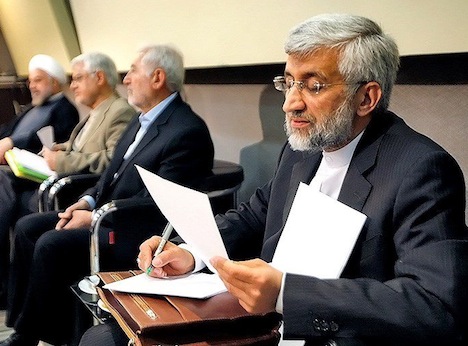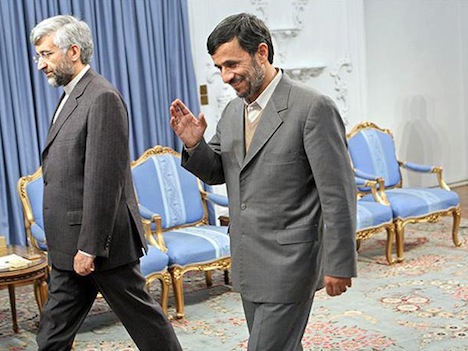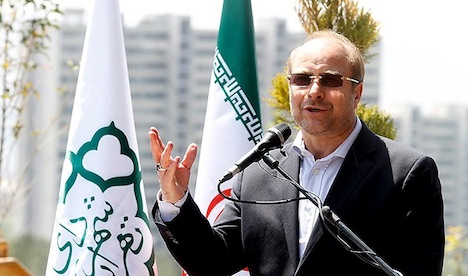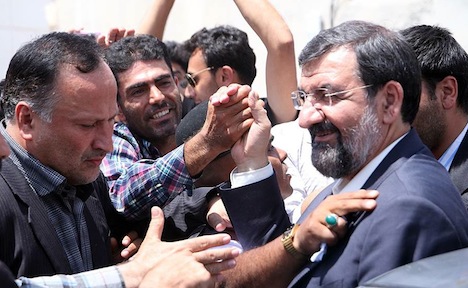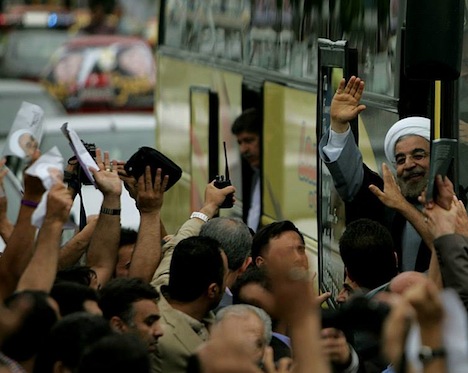It’s been a fast-paced 36 hours in Iran’s presidential election, with two of the eight approved candidates exiting of the race following Friday’s third and final presidential debate. ![]()
Monday brought news that Gholam Ali Haddad-Adel would drop out of the election, reducing the number of conservative ‘principlists’ competing for votes in the first round of the June 14 presidential race. Haddad-Adel, who served as the speaker of Iran’s Islamic Consultative Assembly (Majles) from 2004 to 2008, and whose daughter is married to the son of the Supreme Leader Ali Khamenei, did not specify an endorsement for any particular candidate, though he previously belonged to the ‘2+1 Principlist’ coalition that included former longtime foreign minister Ali Akbar Velayati and Tehran mayor Mohammad Baqer Qalibaf, and his exit from the race will likely mean fewer votes spread among Velayati, Qalibaf and Iran’s current top nuclear negotiator, Saeed Jalili (pictured above preparing for a recent presidential debate).
Today brings the news that Mohammad Reza Aref will also drop out in favor of moderate candidate Hassan Rowhani, which gives moderates and reformists a chance to unite behind one candidate. Aref, who served as communications minister and vice president under former reformist president Mohammed Khatami, allegedly ended his presidential bid after Khatami asked him to step down. Khatami has now endorsed Rowhani, who is seen as more of a moderate than a reformist. Rowhani is very close to former Iranian president Hashemi Rafsanjani, who was controversially disqualified in May to stand as a candidate in the current election by the Guardian Council. It’s a development that wasn’t entirely unexpected, and to the extent reformists and moderates don’t boycott the election entirely, it is very good news for Rowhani, who can try to unite to reformist and moderate camps in the hours ahead of Friday’s vote.
So where does that leave the six-candidate field? Realistically, it’s a five-man race. Though he remains a candidate, it’s hard to believe that Mohammad Gharazi could win. Although he served as Iran’s oil minister from 1981 to 1985 and as communications minister from 1985 to 1997, he’s a leftist in the mould of Mir-Hossein Mousavi, who served as prime minister in the 1980s before his resurrection as a reformist presidential candidate in 2009. He’s run a campaign focused largely on economic management and controlling inflation.
The remaining five — three principlists, another independent conservative and a reformist/moderate — are not so much vying to win outright on Friday so much as vying to win one of two spots in a runoff that will be held on the following Friday, June 21 in the event that no candidate wins over 50%. If that happens, as seems likely, there’s really no way to know who will emerge in the top two spots. Though polling is not incredibly reliable in Iranian elections, a recent telephone poll by the U.S.-based IPOS indicates 57% of Iranians have not yet decided but, among those who have, Qalibaf has a wide lead of around 40% against the remaining four candidate essentially tied for second between around 10% and 20%. That generally corresponds to other field polls, though Rowhani has led other similar polls. Rowhani has led the lion’s share of unscientific online polls since the campaign began in earnest, but those are even less reliable indicators of true support.
So what are the chances for each of those five candidates? Here’s a look at the pros and cons of each candidate, and how each would shape up in a potential runoff.
Saeed Jalili
Jalili (pictured above, left, with incumbent Mahmoud Ahmadinejad) has been secretary of Iran’s Supreme National Security Council and the current chief negotiator on Iran’s nuclear energy program with the six major ‘P5+1′ countries – the United States, Russia, China, the United Kingdom, France and Germany. At age 47, he’s the youngest candidate, and like Qalibaf, he represents a new generation of Iranian leadership. He served in the Revolutionary Guards in the 1980s in the war against Iraq and lost part of his right leg in battle.
Pros: Western and Iranian media have seemingly determined that Jalili is the frontrunner in the election, and there’s some bandwagon magic that has affixed itself to his campaign. As a relatively muscular nuclear negotiator, he has in many ways turned the campaign into a binary between his approach and that of Rowhani, Iran’s former nuclear negotiator. In light of Velayati’s closeness to Khamenei and in light of Qalibaf’s past clashes with Ahmadinejad, Jalili is seen as the most likely candidate to unite both Khamenei’s supporters and Ahmadinejad’s supporters, and there’s a lot of circumstantial evidence to suggest that Ahmadinejad is quietly backing Jalili.
Cons: He is as close to an incumbent as any other candidate in the race in which voters are likely to not to be happy with Iran’s current economic woes, which means that reports linking him to Ahmadinejad may be meant to damage his campaign. Also, don’t necessarily believe reports that have anointed Jalili as the frontrunner. He’s also never run for elected office in Iran, his flowery prose remains somewhat short on details (especially with respect to the economy), and he’s neither the most charismatic campaigner nor the most populist voice among the top contenders. In both 1997 and in 2005, the alleged frontrunner lost in landslides to dark-horse challengers: the reformist Khatami in 1997 against Majles speaker Ali Akbar Nateq-Nouri, and the conservative Ahmadinejad in 2005 against Rafsanjani.
Runoff chances: A runoff that pits Jalili against Qalibaf would be Jalili’s toughest match, because Qalibaf would be able to position himself as both a change candidate and a principlist candidate, and Qalibaf would also have a built-in advantage among Tehran’s voters. Otherwise, however, there’s no reason to assume Jalili couldn’t win against any of the remaining candidates, including a traditional conservative-liberal face-off against Rowhani or a generational faceoff against fellow conservatives Rezai or Velayati.
Mohammad Baqer Qalibaf
Qalibaf (pictured above) is the mayor of Tehran, elected by the city council after its previous mayor (Ahmadinejad) became Iran’s president. He was formerly the head of Iran’s national police forces and played a role in suppressing both the student protests in 1999 and the ‘Green movement’ protests following the 2009 election. Nonetheless, he’s won international recognition as among Iran’s more thoughtful public servants, having founded the ‘110’ emergency hotline (an equivalent to ‘911’) as police chief and having developed many projects to make Tehran’s public services more modern, efficient, and environmentally-friendly, including improved public transportation and greater parks and green spaces.
Pros: As he’s been in office since 2005 as Tehran’s mayor, so he has a power base unlike no other candidate in the race, which may explain why he’s done so well in polls and why he may be the likeliest to emerge as Iran’s next president. After all, Ahmadinejad came to Iran’s presidency in 2005 after just a couple of years as Tehran’s mayor. Qalibaf has a largely strong record in favor of his accomplishments in Tehran, and his political profile is strong enough that he was a plausible contender for the presidency in both 2005 (he ultimately finished fourth) and in 2009 (he chose not to run). His criticism of Ahmadinejad goes back eight years, so while Ahmadinejad won’t race to support him, there’s also no chance that he will be tarred with the unpopularity of the failures of Ahmadinejad’s administration. Like Ahmadinejad and Jalili, he belongs to the second generation of Iranian conservatives that came of age fighting in the Republican Guards during the crucible of the 1980s war against Iraq.
Cons: He is seen as more independent from Khamenei than either of the other main principlists in the race. Although that is likely to help him in a potential runoff, it could also squeeze him out of the first round if moderates back Rowhani and conservatives back Jalili and Velayati instead. It’s also unclear how much support Qalibaf has outside Tehran and other major cities, though he’s been campaigning across the country this week.
Runoff chances: Qalibaf certainly seems well situated to succeed if, as polls suggest, he makes it to the runoff. If he’s pitted against one of the other principlists, he’ll have positioned himself as the more independent candidate, which could draw the votes of reformists and moderates. If he’s up against Rowhani, he’ll certainly win the votes of many conservatives of all colors, who would be dismayed to see a Rafsanjani ally and moderate win the presidency. They’ll flock to Qalibaf simply in order to keep Rowhani out of power.
Mohsen Rezai
Rezai (pictured above, right) is the secretary-general of the Expediency Discernment Council and the former chief of the Revolutionary Guards from 1981 to 1997.
Pros: Rezai is consistently proven to be a popular conservative voice who has challenged Ahmadinejad from the right in recent years, including during the 2009 presidential election. This is Rezai’s third consecutive presidential race, so he’s a relatively well-known and popular political quantity. As the former head of the Republican Guards, he’ll likely garner much strength from within the Guards, though he by no means has a lock on their support. He’s been one of the strongest voices in the campaign for ethnic minorities, which may appeal not only to Kurds in northwestern Iran, but to Balochs in southeastern Iran as well.
Cons: His support was so negligible in 2005 that he dropped out of the race and he won just about 1.75% in the 2009 election. There’s no reason to assume that Iranians will suddenly flock to him this time around. He’s also viewed as somewhat of a loose cannon, especially in contrast to other principlist candidates like Jalili and Velayati. He’s also a controversial figure internationally in relation to his alleged role in the 1994 attack on the Argentine Jewish cultural center in Buenos Aires that killed 85 people — since 2007, he’s been on Interpol’s wanted list.
Runoff chances: Rezai would face difficulties in a runoff scenario, especially in light of his Interpol troubles. Given Rezai’s reputation for independence, Khamenei may well find himself ambivalent as between Rezai and the more measured Rowhani. It’s easy to see some principlists supporting Rowhani against Rezai in a runoff, though it’s hard to imagine very many moderates or reformists cuddling up to a conservative who’s also an alleged international criminal.
Hassan Rowhani
Rowhani (pictured above) was Rafsanjani’s deputy in the 1980s and the deputy speaker of the Majles from 1992 to 2000, and is currently a member of the Assembly of Experts. He served as secretary of the Supreme National Security Council from 1989 to 2005 and as Iran’s chief international nuclear program negotiator from 2003 to 2005.
Pros: With Aref’s withdrawal from the race, Rowhani seems well-placed to unite the reformist vote and the moderate vote that would have otherwise supported Rafsanjani in the election. He’s taken steps in recent days to suggest that Iran should take steps to end the house arrest of Mousavi and another 2009 reformist candidate, Mehdi Karroubi, and to release the remaining prisoners from the 2009 election protests. He’s also attacked the more authoritarian aspects of Iran’s government, including the harassment of Iranian citizens by plainclothes members of the Basij, a volunteer paramilitary militia.
Cons: Rowhani is not Rafsanjani, though. He’s a cleric, and his time as Iran’s top nuclear negotiator is seen by many voters as a failure in light of the fact that he agreed to suspend Iran’s nuclear program, a conciliatory step that is now seen as a capitulation to the United States and to the West that resulted in little benefit for Iran. While he’s the most reformist of the candidate remaining in the race, he’s still close enough to Khamenei that true reformist-minded voters may remain skeptical of supporting him.
Runoff chances: It’s hard to know just how well Rowhani would do in a runoff, though it seems clear that the Guardian Council believes a Rowhani win is plausible, given reports that it was considering a move to disqualify him earlier on Monday. In a country where the reformist Khatami won nearly four-fifths of the vote in the 2001 presidential election and conservative populist Ahmadinejad won two-thirds of the vote in the 2005 election, anything could happen. It’s tempting to believe that Qalibaf would prove a wilier opponent for all the reasons described above. Rowhani might welcome a runoff against Velayati or Jalili, given that both are relative newcomers to elective Iranian politics and that they represent a starker contrast to Rowhani. A Jalili-Rowhani runoff, however, would largely come down to a dueling vision of Iran’s approach to international negotiations over its nuclear program.
Ali Akbar Velayati
Velayati is the second of the two remaining ‘2+1 Principlist’ coalition candidates in the race. He’s currently an adviser to Khamenei on international affairs and he served as Iran’s foreign minister from 1981 to 1997 during the presidencies of Khamenei, Rafsanjani and Khatami.
Pros: As the candidate closest to the Supreme Leader, Velayati may be seen by many voters as Khamenei’s implicit choice for president, which could boost his support (to the extent Khamenei’s support is seen as a positive by voters). In joining with Rowhani during the debates to criticize both Jalili’s performance as a nuclear negotiator and Ahmadinejad’s economic record, he has positioned himself as someone who will change Iran’s economic and political course, but not radically so. He recently won the backing of the Qom Seminary Scholars Organization, which could give him additional momentum as Friday approaches. In contrast to Jalili and Ahmadinejad, he can point to his nearly two decades as foreign minister as a time when Iran defied the West, but did so in a way that didn’t result in its nearly complete international isolation.
Cons: He indicated earlier in the race that he would likely drop out in favor of another principlist, perhaps even Jalili, so his withdrawal from the race between now and Friday remains a distinct possibility. As a member of the founding generation of Iran’s Islamic revolutionaries, he could be seen as yesterday’s man.
Runoff chances: Velayati has not garnered the international attention that Jalili, Qalibaf or Rowhani have during the election campaign, so it’s hard to know just how well he could do on Friday and beyond. Qalibaf would obviously bring a lot of political talent against Velayati. But Velayati would be able to unite conservatives in a race against Rowhani, and he would be able to run against Jalili not only as a candidate of change, but as the candidate of arguably superior competence and experience.
